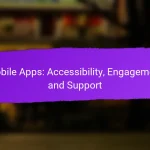Crowdfunding platforms serve as vital tools for individuals and organizations seeking to raise funds for their projects by tapping into the support of a large online community. Each platform offers distinct features, fee structures, and engagement opportunities, making it important for creators to select one that aligns with their specific goals and project types. By understanding the associated fees and functionalities, users can effectively plan their campaigns and maximize their funding potential.
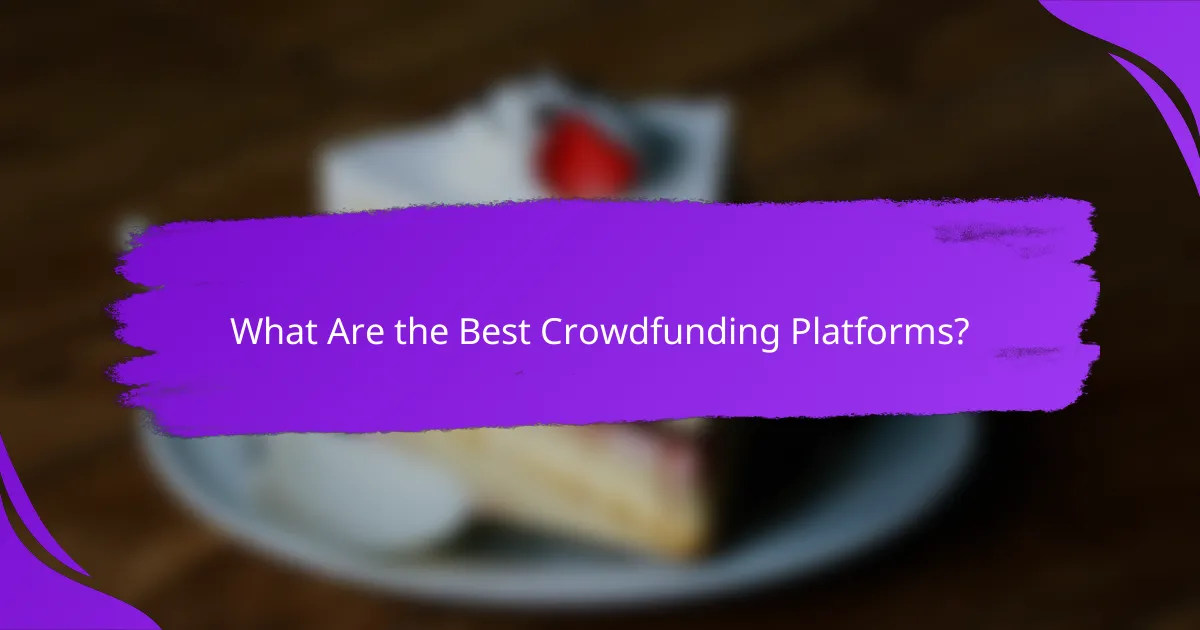
What Are the Best Crowdfunding Platforms?
The best crowdfunding platforms vary based on project type, funding goals, and community engagement. Each platform has unique features and fee structures that cater to different needs, making it essential to choose one that aligns with your objectives.
Kickstarter
Kickstarter is a popular platform for creative projects, including art, music, and technology. It operates on an all-or-nothing funding model, meaning projects must reach their funding goal to receive any money. This approach encourages backers to contribute, knowing their funds will only be used if the project is fully funded.
Creators should prepare a compelling campaign with engaging visuals and a clear funding goal. Successful projects often offer attractive rewards for backers, such as exclusive merchandise or early access to products. Keep in mind that Kickstarter charges a fee of around 5% on funds raised, plus payment processing fees.
Indiegogo
Indiegogo offers flexibility with both fixed and flexible funding options, allowing creators to keep funds even if their goals are not met. This platform supports a wide range of projects, from innovative gadgets to social causes. Indiegogo also provides tools for ongoing fundraising, making it suitable for long-term projects.
When using Indiegogo, consider setting realistic funding goals and timelines. The platform charges a similar fee structure to Kickstarter, with around 5% taken from funds raised. Engaging with your backers through updates and communication can significantly enhance your campaign’s success.
GoFundMe
GoFundMe is primarily focused on personal causes and charitable projects, such as medical expenses or community initiatives. Unlike other platforms, it does not require a funding goal to be met, allowing users to withdraw funds at any time. This makes it accessible for urgent needs or ongoing support.
While GoFundMe does not charge a platform fee, payment processing fees apply, typically around 2.9% plus a fixed fee per donation. To maximize contributions, share your campaign widely on social media and provide regular updates to your supporters.
Patreon
Patreon is designed for creators who want to build a subscription-based income through ongoing support from fans. Artists, podcasters, and writers can offer exclusive content to patrons in exchange for monthly contributions. This model fosters a community around your work and provides a steady income stream.
Creators should define clear membership tiers with varying benefits to attract different levels of support. Patreon takes a percentage of earnings, which can range from 5% to 12%, depending on the plan chosen. Consistent engagement with patrons is crucial for retention and growth.
SeedInvest
SeedInvest is an equity crowdfunding platform that allows startups to raise capital by offering equity in their company. This platform is suitable for entrepreneurs looking to attract investors who want a stake in their business. SeedInvest has a rigorous vetting process, ensuring that only high-quality startups are listed.
To succeed on SeedInvest, startups should prepare a detailed business plan and financial projections. The platform charges a fee of around 7.5% on funds raised, making it essential to factor this into your funding strategy. Engaging with potential investors through updates and transparent communication can enhance trust and interest in your venture.
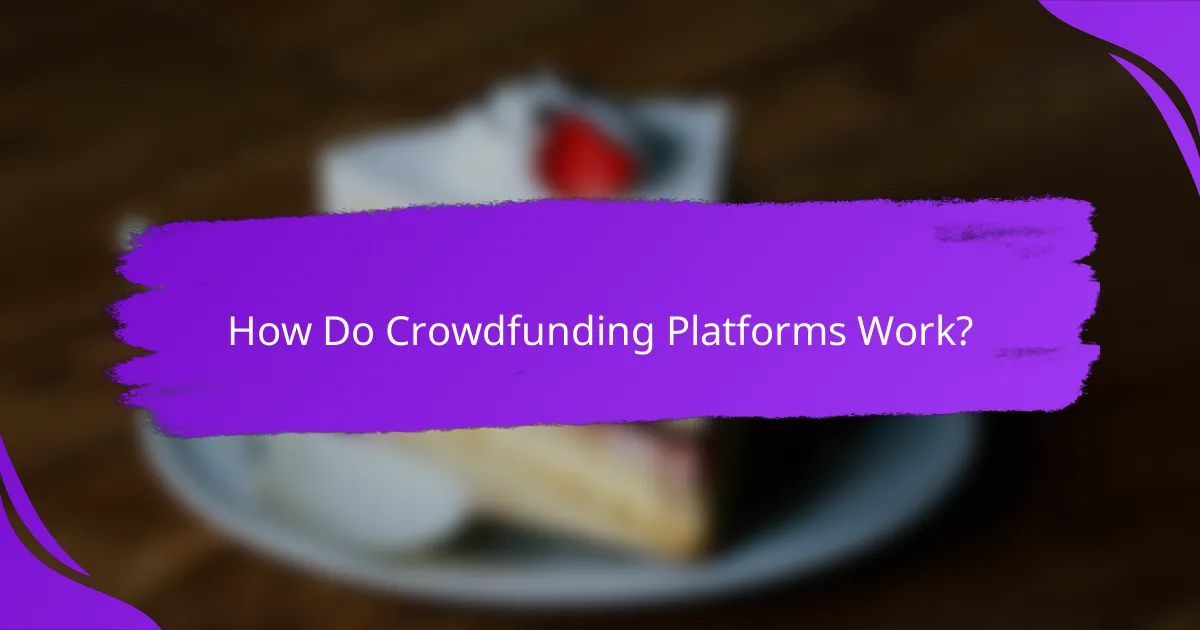
How Do Crowdfunding Platforms Work?
Crowdfunding platforms facilitate the collection of funds from a large number of people, typically via the internet, to support various projects or ventures. Users can submit their ideas, set funding goals, and offer rewards or equity in return for contributions.
Project submission process
The project submission process typically begins with creators registering on the crowdfunding platform and providing detailed information about their project. This includes a compelling description, funding goals, timelines, and any rewards for backers.
Many platforms require a review of the project before it goes live to ensure it meets community guidelines and standards. Creators should focus on presenting clear, engaging content and high-quality visuals to attract potential backers.
Funding models
There are several funding models used by crowdfunding platforms, including reward-based, equity-based, and donation-based models. In reward-based crowdfunding, backers receive tangible rewards or experiences, while equity crowdfunding allows investors to gain shares in the company.
Donation-based crowdfunding is often used for charitable causes, where contributors do not expect any financial return. Each model has its own advantages and considerations, so creators should choose one that aligns with their project goals and audience.
Community engagement
Community engagement is crucial for a successful crowdfunding campaign. Creators should actively communicate with their backers through updates, comments, and social media to build trust and maintain interest.
Engaging with the community can also lead to valuable feedback and support, helping to refine the project and attract more contributions. Offering exclusive content or early access to backers can further enhance community involvement and loyalty.
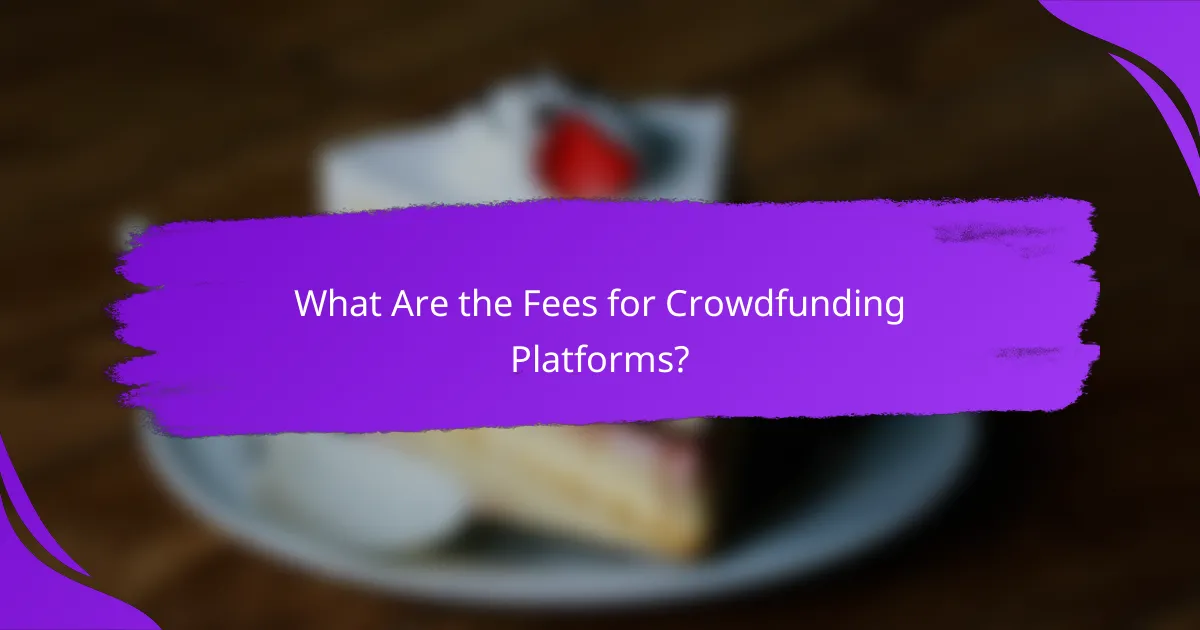
What Are the Fees for Crowdfunding Platforms?
Fees for crowdfunding platforms typically include percentage fees based on the funds raised, payment processing fees, and possible additional costs. Understanding these fees is crucial for creators to accurately assess their net funding and plan their campaigns effectively.
Percentage fees
Percentage fees are charged by crowdfunding platforms as a portion of the total funds raised. This fee usually ranges from 3% to 10%, depending on the platform and the type of campaign. For example, a platform may charge 5% on funds collected, meaning if you raise $10,000, the fee would be $500.
Some platforms offer lower fees for non-profit campaigns or specific projects, while others may have tiered structures based on the amount raised. Always review the fee structure before choosing a platform to ensure it aligns with your funding goals.
Payment processing fees
Payment processing fees are separate from percentage fees and cover the costs of handling transactions. These fees typically range from 2% to 5% of the total funds raised, depending on the payment processor used by the platform. For instance, if a platform uses PayPal, the processing fee might be around 2.9% plus a fixed fee per transaction.
It’s important to factor these fees into your overall budget, as they can significantly impact the final amount you receive. Some platforms may bundle these fees with their percentage fees, while others list them separately, so check the details carefully.
Additional costs
In addition to percentage and payment processing fees, there may be other costs associated with crowdfunding campaigns. These can include marketing expenses, shipping costs for rewards, and platform-specific fees for features like promotional tools or analytics. Depending on your campaign, these additional costs can add up quickly.
To avoid surprises, create a detailed budget that includes all potential expenses. Consider using a checklist to track these costs, ensuring you account for everything from promotional materials to fulfillment of backer rewards.
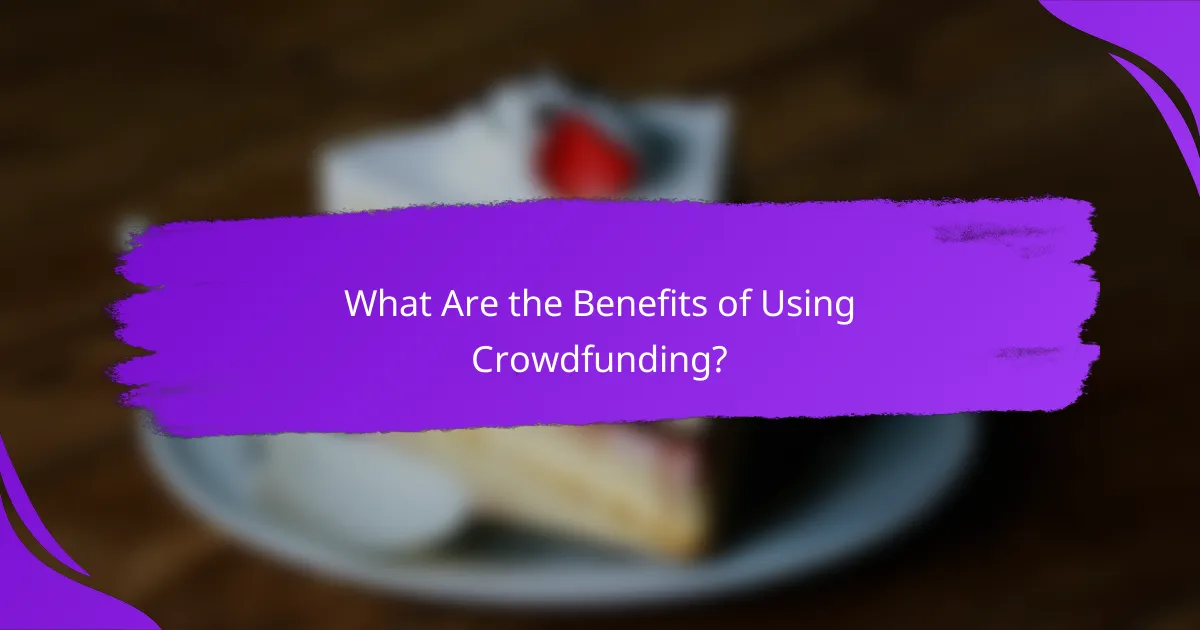
What Are the Benefits of Using Crowdfunding?
Crowdfunding offers several advantages, including access to capital, market validation, and community support. These benefits can significantly enhance a project’s chances of success and provide valuable insights during the development phase.
Access to capital
Crowdfunding enables entrepreneurs and creators to raise funds from a large number of people, often through online platforms. This method can provide access to capital that might be difficult to secure through traditional financing options like bank loans or venture capital.
Typically, crowdfunding campaigns can raise anywhere from a few hundred to several million dollars, depending on the project’s appeal and marketing strategy. It’s essential to set realistic funding goals and clearly communicate how the funds will be used to attract backers.
Market validation
Launching a crowdfunding campaign can serve as a litmus test for your product or idea. By gauging public interest and receiving feedback, you can validate your concept before committing significant resources to development.
Successful campaigns often indicate a strong market demand, while unsuccessful ones can highlight areas needing improvement. This feedback loop allows creators to refine their offerings based on real consumer input, increasing the likelihood of future success.
Community support
Crowdfunding fosters a sense of community among backers, who often feel personally invested in the project’s success. This support can lead to a loyal customer base and valuable word-of-mouth marketing.
Engaging with your community through updates and interactions can strengthen these relationships. Consider offering exclusive rewards or early access to products for backers, which can enhance their commitment and encourage ongoing support throughout the project’s lifecycle.
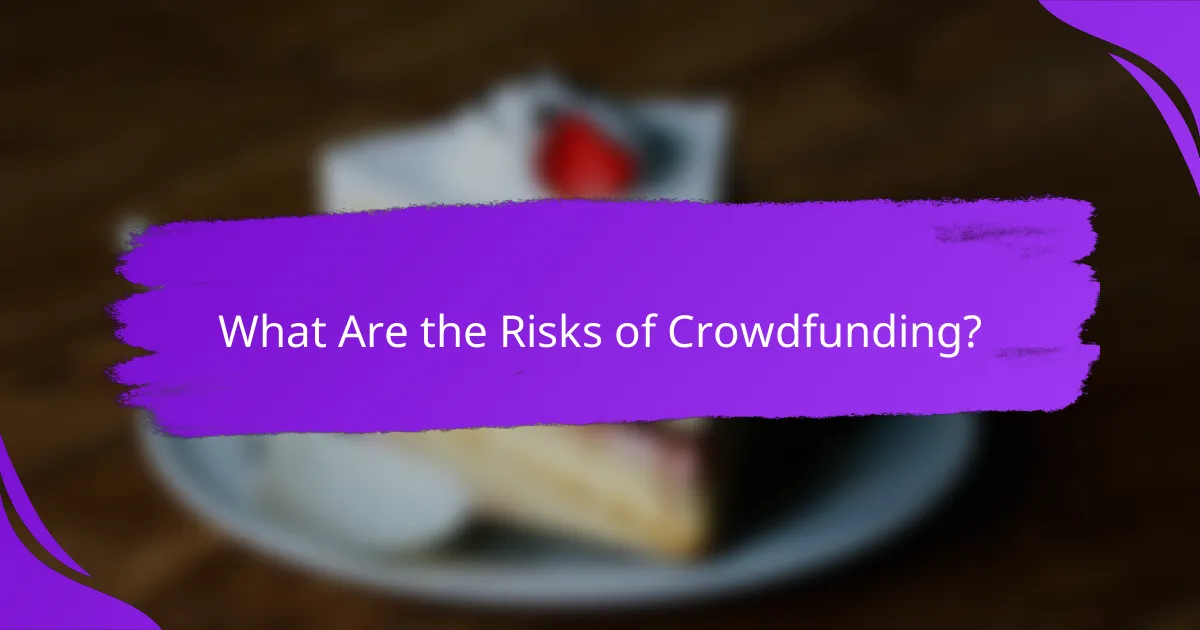
What Are the Risks of Crowdfunding?
Crowdfunding carries several risks that can impact both project creators and backers. Understanding these risks is crucial for making informed decisions about participating in crowdfunding campaigns.
Funding failure
Funding failure occurs when a crowdfunding campaign does not reach its financial goal, resulting in no funds being collected. This can happen for various reasons, including poor marketing, lack of interest, or unrealistic funding targets.
To mitigate the risk of funding failure, creators should set achievable goals and actively engage with potential backers through social media and other channels. Researching similar successful campaigns can provide insights into effective strategies.
Intellectual property concerns
Intellectual property (IP) concerns arise when creators share their ideas publicly, which may lead to theft or misuse. Once a project is launched, others may replicate the concept, especially if it is not adequately protected by patents or trademarks.
To protect intellectual property, creators should consider filing for patents or trademarks before launching their campaigns. Additionally, they can use non-disclosure agreements (NDAs) when discussing their projects with potential partners or investors.


